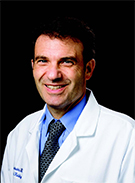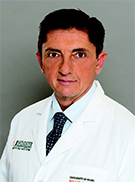TACE Advancements Benefit Patients Battling Liver Cancer
Technology is fueling advancements in transarterial chemoembolization (TACE) in fighting hepatocellular carcinoma


Advancements in transarterial chemoembolization (TACE) are improving the odds for patients with a common type of liver cancer, according to researchers who have been studying the procedure for more than a decade.
In the interventional procedure, a catheter is threaded under imaging guidance to the artery or arteries in the liver that supply a tumor with blood.
After having ensured that the catheter is in good position, chemoembolytic agents are released to destroy the tumor and partially cut off its blood supply.
Developed in Japan in the 1980s, TACE quickly produced benefits for patients with intermediate-stage hepatocellular carcinoma (HCC) that was too advanced for surgery. Despite its promise, TACE had a limited impact on medicine through its first decade of use, said Jean- François H. Geschwind, M.D., chair of the Department of Radiology and Biomedical Imaging, professor of radiology and oncology, Yale University School of Medicine, and chief of the Department of Radiology, Yale-New Haven Hospital, Conn., who presented a session on TACE techniques at RSNA 2015 and co-authored a January 2016 Radiology study on TACE.
That changed in 2002 when two major studies showed unequivocal survival benefits for HCC patients who underwent the procedure. HCC, the most common type of liver cancer, predominantly occurs in patients with cirrhosis. Five-year survival rates are low partly because the disease is often not discovered until its later stages, Dr. Geschwind said.
“The disease grows insidiously, often without symptoms, which makes it very difficult to diagnose,” said Dr. Geschwind, who received a 2000 RSNA Research Seed Grant to study chemoembolization in the treatment of liver cancer.
The effectiveness of TACE in battling HCC is due to the unique vasculature of the liver, which has a dual blood supply courtesy of the hepatic artery and the portal vein. Healthy liver tissue receives blood flow mostly from the portal vein; however, most of HCC is nourished by the hepatic artery, making it possible to block the tumorbearing parts of the blood supply without harming healthy liver tissue.
“We can exploit this to our advantage by delivering toxic chemicals and radiation beads through the artery for natural anatomic targeting of tumors,” Dr. Geschwind said.
The targeted approach helps spare patients from the side effects of systemic chemotherapy, as evidenced in an October 2008 study in Radiology by Dr. Geschwind and colleagues. The researchers examined 190 patients with HCC and found that toxicity rates associated with TACE were considerably lower than those reported after treatment with systemic chemotherapeutic agents.
Technology Fuels TACE Advancements
Since the landmark TACE studies of 2002, improvements in everything from catheters to imaging technology have helped make the technique even more effective. MRI is typically used to plan TACE while the actual embolization is performed under X-ray guidance in the angiography suite. The X-ray tube rotates around the patient, obtaining CT-like images in two phases, while the software automatically segments the tumor and correlates it with blood vessels.
This technology creates something like a Google map of the roads you have to take to get to the tumor,” Dr. Geschwind said.
Imaging advances also allow for more precise delivery of drugs to the tumors. The most commonly used drug is Lipiodol, a drug-bearing emulsion that sticks to the tumor cells. Imaging helps clinicians get as close to the tumor as possible and saturate it and the surrounding area to make sure the entire tumor is treated, according to Dr. Geschwind.
“This is where imaging tools really help you,” he said. “Many times there is more than one vessel providing blood flow to the tumor, and the software allows you to see all the arteries involved.”
Riccardo A. Lencioni, M.D., professor of radiology at the University of Miami Miller School of Medicine and directorof interventional oncology research at the Sylvester Comprehensive Cancer Center in Miami, recently published a major review of existing research on TACE using Lipiodol-based regimens in the treatment of HCC. The review study, which was co-authored by Dr. Geschwind and appeared in the January 13 online edition of Hepatology, concluded that in HCC, survival figures for patients treated with Lipiodol TACE were in line with those reported in the previous key clinical trials, and that no new or unexpected safety concerns were identified.
“This systematic review suggests that with refinements in techniques and more sophisticated approaches with imaging and catheters, treatment can be offered to a broader patient population than what was reported in 2002,” Dr. Lencioni said.
Challenges Exist to Wider Adoption
Current challenges include the adoption of more accurate parameters for measuring the treatment’s success. Relying on tumor size is problematic, Dr. Geschwind said, because liver tumors often do not shrink in response to TACE, even when the cancer cells are killed.
“The U.S. Food and Drug Administration (FDA) does not accept anything else but tumor size as a measure of success,” Dr. Geschwind said. “Clinically we have to come up with new ways to assess response to therapy.”
In 2000, a position paper of the European Association for Study of the Liver, co-authored by Dr. Lencioni, developed new guidelines based on contrast enhancement, with a lack of enhancement indicating cell death. Dr. Geschwind and colleagues affirmed the value of this approach in a 2009 study published in Radiology demonstrating a significant reduction in tumor enhancement within 24 hours after TACE that persisted for up to four weeks.
“The imaging technology has improved so much that we are now already using threedimensional contrast enhancement as measure of the success of therapy,” Dr. Geschwind said. “This is how far we have come.”
Along with Lipiodol, other new and improved drugs are also being developed, including smaller drug-eluting beads with an improved elution profile. Researchers are working to make the beads radio-opaque so that they can be seen at the time of the procedure.
“The drugs currently used for TACE are cytotoxic agents,” Dr. Lencioni said. “Several new anticancer agents, including moleculartargeted and immuno-oncology drugs, are currently available and will require proper investigation in the setting of TACE regiments.”
The January 2016 Radiology study by Drs. Geschwind and Lencioni examined TACE in combination with Sorafenib, a molecular targeted agent that is taken orally as a pill. Though no benefit to the addition of Sorafenib was shown, the approach was well tolerated by the patients and more studies are on the horizon.
“We still need to understand what is the best drug or combination of regimens that will result in the best outcome,” Dr. Lencioni said.
The refinement to TACE points to a broader future role in HCC treatment. TACE could be an alternative for patients with early-stage HCC who are not eligible for radiofrequency ablation (RFA) or surgery, and it could be added to RFA in patients with early stage HCC for better local tumor control than RFA alone. TACE has advantages over RFA, according to Dr. Geschwind, since ablation is limited by the size and location of the tumor. TACE could also serve as bridge therapy for patients awaiting liver transplantation.
“Chemoembolization is continuously improving,” Dr. Geschwind said. “Some studies show it could be equivalent to ablation in early stage liver cancer, and as the technology improves we are using it more frequently even in that context.”
The continued evolution of TACE will be critical as there has been a doubling of the HCC age-adjusted incidence rates in the U.S., over the past three decades, possibly due to the increasing rate of hepatitis C. Mortality rates have increased faster for HCC than for those of other leading cancers, according to Dr. Geschwind.
Web Extras
- The Radiology studies authored by Drs. Geschwind, Lencioni and colleagues are available at RSNA.org/Radiology.
- The Hepatology study authored by by Drs. Lencioni, Geschwind and colleagues is available at AASLD.org.